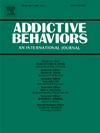Serious harm reduction protective behavioral strategies reduce consequences associated with alcohol-induced blackouts in college students
IF 3.7
2区 医学
Q1 PSYCHOLOGY, CLINICAL
引用次数: 0
Abstract
Objective
Alcohol-induced blackouts (AIBs) have been associated with increased alcohol-related consequences. Serious harm reduction (SHR) protective behavioral strategies may reduce consequences when students are drinking heavily. We examined whether SHR weakened the relationship between AIBs and a) total consequences and b) serious consequences (e.g., sexual assault) only.
Methods
Students were eligible if they were aged 18–22 years, in their second or third year of college, reported drinking 4 + drinks on a typical Friday or Saturday, experienced ≥ 1 AIB in the past semester, owned an iPhone, and were willing to wear a sensor for 3 days each weekend. Students (N = 79, 55.7 % female, 86.1 % White, Mage = 20.1) wore sensors and completed daily diaries over four consecutive weekends (852 total surveys; 89.9 % completion rate). Linear multilevel models were conducted to test for moderating effects of SHR.
Results
SHR weakened the association between AIBs and total consequences. At low (−1 SD) SHR, days with an AIB had an additional 1.46 consequences compared to days without an AIB, on average. At high (+1 SD) SHR, days with an AIB had an additional 0.94 consequences compared to days without an AIB, on average. SHR did not change the association between AIBs and serious consequences.
Conclusions
Students experienced approximately 50% more consequences on nights when they had an AIB and used below average numbers of SHR compared to nights when they had an AIB and used above average numbers of SHR. These findings suggest that student drinking interventions should include SHR to reduce harm associated with drinking and AIBs.
严重减少伤害的保护性行为策略减少了大学生因酒精引起的昏厥的相关后果。
目的:酒精引起的昏厥(AIBs)与酒精相关后果的增加有关。严重危害减少(SHR)保护性行为策略可以减少学生酗酒的后果。我们研究了SHR是否仅削弱了AIBs与a)总后果和b)严重后果(如性侵犯)之间的关系。方法:年龄在18-22岁,在大学二年级或三年级,报告在一个典型的周五或周六喝了4杯以上的饮料,在过去的一个学期经历了≥1次AIB,拥有一部iPhone,并且愿意每个周末戴3天传感器。学生(N = 79,女性55.7%,白人86.1%,男性20.1)佩戴传感器,并在连续四个周末完成每日日记(共852份调查;89.9%完成率)。采用线性多水平模型检验SHR的调节效应。结果:SHR减弱了AIBs与总后果之间的关联。在低(-1 SD) SHR下,平均而言,有AIB的天数比没有AIB的天数多出1.46个后果。在高(+1 SD) SHR下,与没有AIB的天数相比,AIB天数的平均后果增加了0.94。SHR并没有改变AIBs与严重后果之间的关系。结论:与AIB和SHR高于平均水平的夜晚相比,AIB和SHR低于平均水平的夜晚,学生经历了大约50%的后果。这些发现表明,学生饮酒干预应包括SHR,以减少与饮酒和AIBs相关的伤害。
本文章由计算机程序翻译,如有差异,请以英文原文为准。
求助全文
约1分钟内获得全文
求助全文
来源期刊

Addictive behaviors
医学-药物滥用
CiteScore
8.40
自引率
4.50%
发文量
283
审稿时长
46 days
期刊介绍:
Addictive Behaviors is an international peer-reviewed journal publishing high quality human research on addictive behaviors and disorders since 1975. The journal accepts submissions of full-length papers and short communications on substance-related addictions such as the abuse of alcohol, drugs and nicotine, and behavioral addictions involving gambling and technology. We primarily publish behavioral and psychosocial research but our articles span the fields of psychology, sociology, psychiatry, epidemiology, social policy, medicine, pharmacology and neuroscience. While theoretical orientations are diverse, the emphasis of the journal is primarily empirical. That is, sound experimental design combined with valid, reliable assessment and evaluation procedures are a requisite for acceptance. However, innovative and empirically oriented case studies that might encourage new lines of inquiry are accepted as well. Studies that clearly contribute to current knowledge of etiology, prevention, social policy or treatment are given priority. Scholarly commentaries on topical issues, systematic reviews, and mini reviews are encouraged. We especially welcome multimedia papers that incorporate video or audio components to better display methodology or findings.
Studies can also be submitted to Addictive Behaviors? companion title, the open access journal Addictive Behaviors Reports, which has a particular interest in ''non-traditional'', innovative and empirically-oriented research such as negative/null data papers, replication studies, case reports on novel treatments, and cross-cultural research.
 求助内容:
求助内容: 应助结果提醒方式:
应助结果提醒方式:


